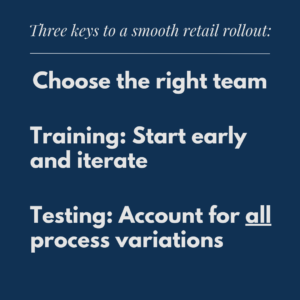
Retail technology rollout: Three keys to succeed
Scott Higley
Sr. Solutions Manager
Retailers face a spectrum of complexity when rolling out new technology to their stores. Deploying a new tech can seem relatively simple at first, but when multiplying the effort to hundreds of locations and thousands of employees, it inevitably gets harder. Furthermore, the closer the new tech is to the customer experience and order processing, the more difficult the rollout.
Often the most complex tech to implement are POS applications and connected hardware. These could be deployed to lanes or cash wraps in the form of fixed terminals or remain more mobile with tablets. For retailers, these projects entail large capital investment and are generally aimed at unifying commerce, differentiating the customer experience, and cloud modernization for greater security.
Based on my experience overseeing retail deployments in numerous stores, here are three key recommendations for ensuring a successful rollout:
 Choose the right team
Choose the right team
Retailers will need to tap into their own teams and partner with experienced service providers to be successful. When it comes to choosing your own team, look for individuals with a strong handle on retail operations. In many instances, these can be store managers at your best stores who have seen it all. If they are to take a prominent role in designing the technology to roll-out, they need to also be a strong internal champion of the change.
Regarding partner selection, the more project complexity the more experience you will want your partner to have. Good service partners will provide you with insight into aspects of the deployment that you may not otherwise consider. They will take a lead role in planning and executing the project in a way that balances factors such as risk, timeline, and budget. A good partner will be hyper-focused on the cutover and roll out plan of the implementation as it will help result in success if done right or spectacular failure if not. Pick a partner with a real proven track record and good referenceable customers. I could write a whole blog on this topic, but hopefully you are getting the point.
Train, train, train...and train some more
The right team means very little if you neglect training. Training is too often an afterthought. The larger the technology changes, the greater emphasis training requires. Remember to start early and iterate. As decisions on process flows are made during the project, be sure to build training documents. Should you have the means, video training that is formatted in small digestible chunks is probably the best way to go. It is impossible to prevent all training related issues, but if you train frequently and well, you will position your team to avoid many headaches during roll out.
Test, test, test...and test again
Testing is such a crucial element of complex retail rollouts. Plan your timing and approach early to testing. Generally, we recommend simulating go-live at least 3 times. Test scripts cannot focus on just happy path, they need to account for all process variations. In your testing you will often need to validate connections to hardware or integrations with other 3rd party software. For example, if the POS is being replaced it will often affect the pin-pads used with associated credit card gateways and processors. Always be sure to test every credit card type (Visa, Amex, Mastercard, etc.) and payment processing variation to be sure you don’t have any money issues when rolling out to stores. Assuming you listened to the first recommendation, you will have a good team throughout this testing, but it is also important to quantify testing efforts and breadth.
As the AI era continues to innovate retail, we are going to see new and interesting opportunities worth pursuing. Should you need to roll out new technology to your stores, remember these above recommendations to get the most out of your investment. Please feel free to reach out if you would like to chat about more specifics.
Tackling a tough retail implementation?
Speak with one of our retail experts today.


